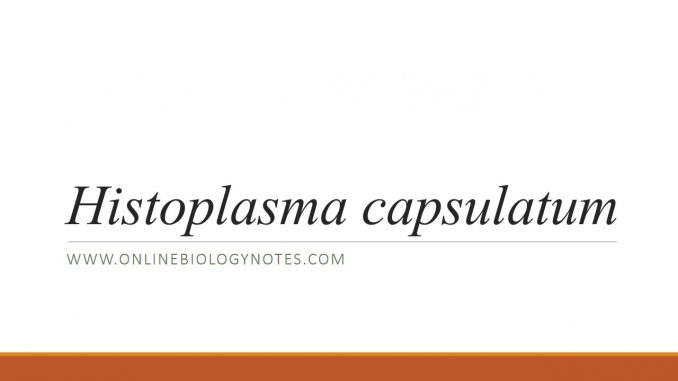
Histoplasma capsulatum-Histoplasmosis and Types of Histoplasmosis, Pathogenesis, Lab diagnosis, Treatment, Prevention and Control
Histoplasma capsulatum
- It is a thermally dimorphic fungi exist either yeast or mold form.
- There are two varities of Histoplasma-
- capsulatum var dubosii
- capsulatum var capsulatum
- Both varities are thermally dimorphi fungi, existing as hyline mold form in nature and in culture at 25°C and intercellular budding yeast form in culture at 37°
- Habitat: they are found throughout the world, mostly in template climate
- Histoplasma mold form two types of asexual spores-

- Macroconidia-large spherical, 5-15µm conidiospore
- Microconidia=small elliptical or oval 2-9µm sessile spore
- Histoplasma yeast-it is 2-4µm oval found intracellularly.
Histoplasmosis: a fungal disease
- Histoplasmosis is an intracellular mycosis of reticuloendothelial system
- It is a systemic infection involving lymphatic tissue, liver, spleen, Kidney, bone marrow and other body parts
- Also known as Cave dweller’s disease or Darling disease or Reticuloendothelial cytoplasmosis or Ohio valley disease.
Types of Histoplasmosis:
- Primary acute Histoplasmosis
- Severe disseminated or systemic infection
- Chronic Pulmonary Histoplasmosis
- Ocular Histoplasmosis
Primary acute histoplasmosis:
Incubation period: 5-18 days
- Primary infection is asymptomatic or mild pneumonia like symptoms.
- Non-productive cough
- shortness of breathing,
- hemoptysis
- night fever with sweating
- muscle and joint pain
- weight loss
- malaise
Severe disseminated or systemic infection:
- consolidated lungs
- hepatosplenomegaly, hepatic insufficiency
- high fever
- anaemia and leucopenia
- generalized adenopathy
- multiple ulceration of mouth , pharynx, stomach, intestine
- stiffness of neck and headache
Chronic pulmonary Histoplasmosis:
- pulmonary TB with bilateral infiltrates
- cavity in lungs
- emphysema
- hemoptysis
- productive cough
- low grade fever
Ocular Histoplasmosis:
- eye infection
Pathogenesis:
- infection occurs by inhalation of dust contaminated with H. capsulatum conidia
- Inhaled conidia are phagocytosed by alveolar macrophage and Polymorphoneutrophils (PMN) cell
- Histoplasma conidia are resistant to oxidative burst and lysosomal fusion because the organism have the ability to capture iron and calcium from macrophage and behave as intracellular parasite. The organism also modulate phagolysomal PH.
- The organism multiply rapidly inside macrophage and spread throughout the body
- Due to multiplication of organism, small inflammatory or granulomatous lesion occur in lungs and spleen which heal spontaneously giving calcification
- In case of minority of individuals particularly infants, aged and immune-compromised, chronic cavitation occur in lungs producing symptomatic diseases
Laboratory diagnosis:
Specimen: sputum, respiratory secretion, excised skin, biopsy from lymph node and bone marrow, peripheral blood, scrapping from lesion etc
- Microscopic examination:
- Giemsa or Wright strain stain preparation
- H and e stain
- PAS stain
- Culture:
- Sabouraud dextrose Agar (SDA); Histoplasma form white buffy brown cottony colony with pale yellowish reverse on SDA at 25-30°
- Brain Heart Infusion Agar (BHI) agar: smooth white creamy yellow colored moist yeast like colony appear on BHI agar at 37°
- Glucose cysteine Blood agar
- Potato dextrose Agar (PDA)
- Yeast extract Agar (YEA)
- Lithman’s Oxgall medium
- Serology: Immunodiffusion test, compliment fixation test, ELISA
- PCR/ DNA probe
- Histoplasmin Skin test
- Animal Innoculation: inoculating macroconidia of Histoplasma into the mouse
- Histopathological examination
- X-ray examination
Treatment:
- Amphotericin B: Intravenous drug
- Itraconazole: oral drug
- ketoconazole
- Fluconazole
- Veroconazole
- Pasaconazole
- Supportive therapy and rest
Prevention and control:
- Safety measure during exposure to bats or bird dropping
- Minimize exposure to endemic areas
References:
- https://microbewiki.kenyon.edu/index.php/Histoplasma_capsulatum
- http://pathologyoutlines.com/topic/skinnontumorfungiHistoplasma.html
- http://www.phac-aspc.gc.ca/lab-bio/res/psds-ftss/histoplasma-capsulatum-eng.php
- http://www.mayoclinic.org/diseases-conditions/histoplasmosis/basics/definition/con-20026585
- http://www.healthline.com/health/histoplasmosis#treatments8
- https://en.wikipedia.org/wiki/Histoplasmosis
- https://www.cdc.gov/fungal/diseases/histoplasmosis/risk-prevention.html
- http://www.merckmanuals.com/professional/infectious-diseases/fungi/histoplasmosis
- http://emedicine.medscape.com/article/299054-overview#a3
